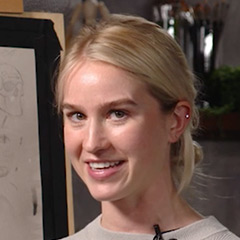
Linear Portrait Block-In: Phase II
Savannah Tate CuffIn portrait drawing, phase two of the block-in moves from establishing the flat planes of the face to working in three-dimensional aspects. Follow artist Savannah Tate Cuff as she explains the process, and as her adjustments become more refined as the drawing evolves. Looking at her completed first phase, Savannah notes that details aren’t yet articulated; she begins that articulation in the forehead area, thinking about it anatomically and using the shadow terminators, or boundaries between light and shadow, to describe form. After looking carefully at her model, Savannah works on darkening the shadow shapes and checking relationships between features as the work gets more specific. As in phase one, she uses model breaks to fill in shadow shapes.
Savannah continues to refine and add dimensionality to the features of the face, describing the forms of the lips and noting cast shadows and form shadows. In this phase, the shadows can be slightly sharp; you’ll soften them in the modeling phase. Be careful not to smudge the drawing (a mahl stick can be helpful). Next, Savannah moves on to articulating the left eye and ear, imagining the forthcoming modeling phase as she goes. As the artist, you decide how much articulation you want before moving on to modeling; it’s up to you. Savannah checks measurements and proportions against the head height once more as she refines the hair, neck, and shoulder area and builds a pleasing gesture for the edges of the hair shape. She adds more details to the eyes—still working on placement in this phase—and notes how the shapes within the eye work together in three dimensions as she prepares for modeling. With articulated shapes and correct placement, the block-in, now complete, sets us up for a smooth modeling phase.
